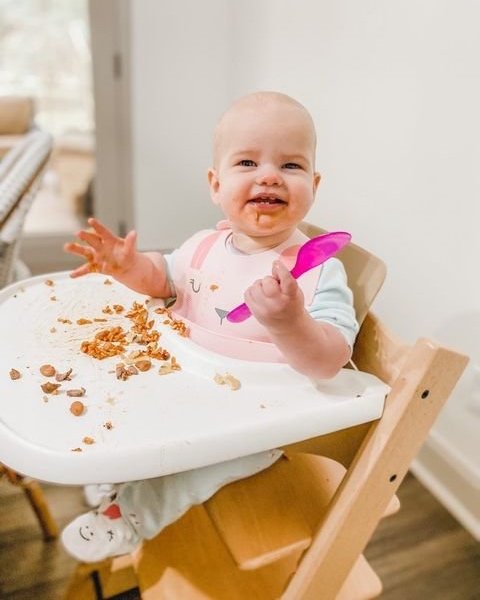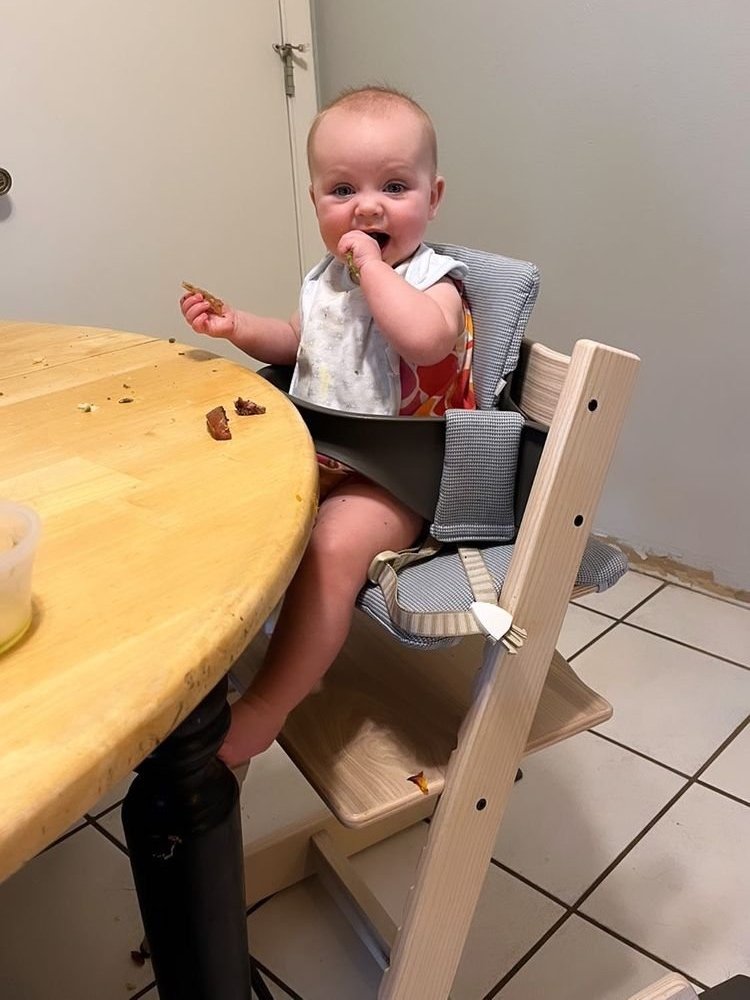When Is a Child Too Old for a High Chair?
This blog contains affiliate links, meaning that if you choose to purchase a product through a link, I will receive a small commission - but this in no way impacts the amount you pay. Affiliate links are marked with an asterisk (*).
A high chair is a great way to help your baby join the family at mealtime.
High chairs help contain the mess and give your baby a little autonomy so they can sit up and self-feed. But eventually, babies outgrow their high chairs.
So when is it time to transition your baby from a high chair to a regular chair at the table?
It really depends on each individual child and their developmental milestones. However, there are some general guidelines that can help you determine when it’s time to graduate from the high chair.
Here’s what you need to know…
What Are the Benefits of High Chairs for Babies?
Once a baby can sit upright with minimal assistance, high chairs provide a safe space to eat meals and explore their surroundings.
There are many benefits to high chairs starting from the early months when a baby can sit up independently and into toddlerhood when a child can sit at the table like the rest of the family. One of the best benefits for parents is, of course, that you have a place to safely seat your baby while they play or eat.
Safety
Thanks to the parents of this 10-month-old cutie for sharing their photo! She is sitting in a Tripp Trapp Stokke high chair* - one of my all-time favorite chair options.
Most high chairs have plenty of safety features like adjustable straps, a point harness, and locks to keep your little one securely in place. These features help reduce the risk of slips or falls. And most high chairs come with adjustable height settings so that you can place your baby at a comfortable height for safe self-feeding.
Whether you're spoon-feeding or doing baby-led weaning, having a place to seat your little one without worrying is convenient for parents, but it benefits the baby too.
While a baby is seated securely, their hands are free to explore food. During baby-led weaning, you can offer food right on the tray or on baby-friendly plates with utensils.
Of course, babies should never be left alone while they're eating. But unless you have a talented escape artist, you generally don't have to worry about them falling over or reaching for anything dangerous if you turn your head for a minute.
That being said, not all high chairs are equally safe. Consumer Reports rated high chairs based on sturdiness, versatility, and ease of cleaning. As an infant and child nutrition expert, I curated my top recommended high chairs that meet these safety standards and have trunk support, adjustable trays, and adjustable footrests.
When choosing a high chair, look for certification stickers from ASTM International, showing that safety standards have been met.
The AAP has a few tips for high chair safety:
Don't leave the high chair near a table or counter, or your little one can use it as leverage to push the chair over.
Don’t leave babies unattended while eating.
Freestanding high chairs are safer than chairs that connect to the table. If you have that kind of chair, make sure it locks onto the table and that your little one can't use their feet to push off the table and dislodge the chair.
Make sure the chair is sturdy and can’t be tipped over.
Be sure folding high chairs are locked when you set them up.
Always make sure your kiddo is seated, and always use the safety straps.
Developmental Skills
High chairs allow babies to interact with others at the table, helping to develop social skills.
On occasion, they're also a great environment for other learning opportunities. By setting up activities like puzzles or blocks around their high chair tray, you can allow your baby to explore new materials while encouraging problem-solving skills and creative thinking.
Having their own space also allows babies to practice self-feeding - which helps them develop fine motor skills and independence during mealtimes.
That being said, it’s important to note that while high chairs are convenient, they should primarily be used for eating. Activity and exploring the environment is essential for physical development and motor skills.
According to the Institute of Medicine’s recommendations to child care centers, time spent in baby equipment that restricts movement should be limited and babies should be allowed to move freely as much as possible, so as much as you can, try to limit high chair time to eating opportunities.
Convenience
A high chair makes meal times much easier by providing a comfortable spot where your baby can stay throughout the entire meal.
As little ones reach new developmental milestones, they'll be able to sit quietly for longer periods of time. However, babies may need a little help from you to keep them occupied throughout the meal. You can offer toys, baby plates, and utensils for your kiddo to play with on the tray. This is a huge help, especially when you're at a restaurant or visiting friends or family.
And yes. It's much more convenient for us as caregivers to have only one spot in the kitchen to clean up after the baby eats!
Indeed, babies make a mess when they eat.
But it’s part of the normal developmental process so finding ways to make clean-up a little easier on you makes mealtime less stressful. Many high chairs come with dishwasher-friendly, removable trays and tray liners which make cleaning up messes after meals quick and easy.
A 14-month-old baby girl exploring textures (like this cutie) can get messy! High chairs help contain messes and make clean-ups easier. Thank you to this baby’s parents for sharing their photo.
When to Stop Using a High Chair
Although many babies can sit up with minimal support starting at around 4 and 6 months old, they don't have the coordination yet to balance on dining chairs or kitchen chairs.
And that's a high distance to fall for a little one.
Kiddos develop at their own pace, but most toddlers are ready to transition out of high chairs between 12 months and 2 years of age. Often by about 18 months, most babies are capable of sitting independently in a regular child-sized chair.
You'll know your child is ready for a booster when they can sit without tipping over or hop down from a chair and land on their feet. If you're unsure whether your baby is ready, watch them for signs that they're getting too big for their high chair.
Once safety is not the primary reason for using the high chair, it’s a good time for a booster seat.
Here are some signs that your toddler may be ready to eat at the table in a booster seat or small chair:
They seem uncomfortable or cramped in their high chair.
They're able to sit up and balance for long periods without falling over.
They’re ready to eat solid foods–If your baby is still on pureed foods or liquids, they may need to stay in their high chair a little longer.
Their legs are cramped when the footrest is in the lowest position.
They try to climb out of their high chair or get frustrated at being confined.
They’re big enough to tip the chair over when they climb up or move around in the chair.
Should a 3-Year-Old Be in a High Chair?
In most cases, no. As kids gain new skills and meet new milestones, they tend to want to use them - especially if they have older siblings and want to mimic what they see them doing.
Most toddlers don’t like to feel physically restricted. And restricting toddlers in a high chair can lead to food refusal, throwing food, or rushing through the meal so they can get down faster.
A 20-month-old girl and her big sister seated with footrests. Thank you to their parents for sharing their photo!
If you notice that this is the case with your little one, transitioning to a small table and chair and/or choosing a booster seat to use at the dining table is a helpful next step.
That being said, babies each develop at their own rate. If a two-year-old is eating well, enjoying the highchair, and joining in family meals happily, continuing to use a high chair is a perfectly valid option as well. You know your child best.
How to Adjust a High Chair
Some high chairs adjust to give kids more autonomy as they reach new developmental milestones.
Before you ditch the high chair, you can also try adjusting the chair to get a few more months of use out of it.
The best high chairs grow with your little one. And some even transition from high chairs into booster seats, giving you a few more years out of that baby furniture investment.
Many high chairs have adjustable footrests, trays, and chairs which enables them to accommodate growing babies. Try adjusting the footrest so your child’s legs have more room but their feet can still stay planted.
If the tray is removable, try removing it and pulling the chair up to the table. This is the best of both worlds. Baby is high enough to join the family at the table, but still safely contained. However, keep in mind that some kids experiment with pushing or kicking off the table, knocking the chair backward. If this is the case with your child, removing the tray may be the last high chair adjustment you’ll be able to safely make before your baby is ready for a big-kid chair.
See this sweet 11-month old girl rocking and rolling in her highchair. Thank you to her parents for allowing me permission to share!
Which booster seat is best for toddler meals?
My favorite booster seats for toddler meals are comfortable, simple to attach to a dining chair, easy to clean, and not likely to slide off a dining chair. The Baby Bjorn booster seat is a great example*.
Has your kiddo graduated to a booster seat yet? Let me know how it went in the comments below.
Need help navigating picky eating behaviors? Check out my free picky eating guide.
And if you are struggling with a specific nutrition-related concern or worried about weight gain or a potential nutrient deficiency, I am currently accepting new clients in my virtual private practice and can help. Book a private session for your baby and/or your child whenever you are ready.










